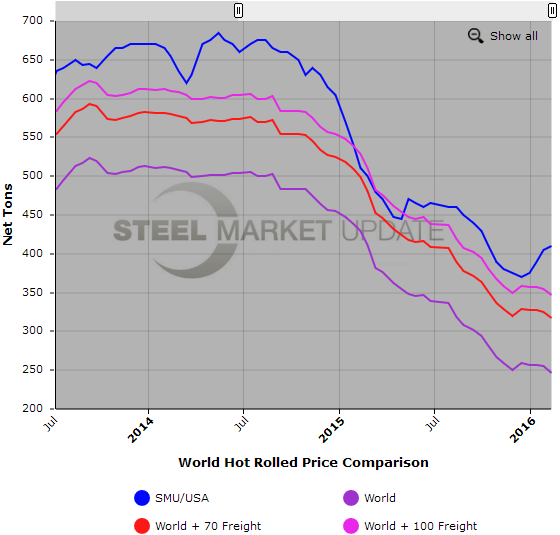International Steel Prices

World Export vs. Domestic Hot Rolled Coil Price Spread Continues to Widen
Written by Brett Linton
February 11, 2016
The following calculation is used by Steel Market Update to identify the spread between world hot rolled export prices as determined by SteelBenchmarker and domestic (US) hot rolled prices as published by SMU. Steel Market Update compares the world hot rolled export price to which dollars are added for freight, handling, trader margin, etc. The number generated is then compared to the spot (FOB Mill) domestic hot rolled price using the SMU Hot Rolled Index average for this week, with the result being the spread between domestic and world hot rolled coil prices. This is a ‘theoretical’ calculation as freight costs, trader margin and other costs can fluctuate ultimately influencing the true market spread.
This theoretical price spread analysis is based on our review of world export prices and the hot rolled steel price index produced by SMU earlier this week. As the spread narrows, the competitiveness of imported steel into the United States is reduced. If it widens then foreign steel becomes more attractive to U.S. flat rolled steel buyers.
One of the concerns SMU hears as we speak to both steel mills and trading companies is what will happen should the spreads between USA and world prices get too large?
![]() The world export price for hot rolled bands is $247 per net ton ($272 per metric ton) FOB the port of export according to data released by SteelBenchmarker earlier this week. This is down $8 from the previous release on January 25th and down $10 per ton compared to the mid-January price.
The world export price for hot rolled bands is $247 per net ton ($272 per metric ton) FOB the port of export according to data released by SteelBenchmarker earlier this week. This is down $8 from the previous release on January 25th and down $10 per ton compared to the mid-January price.
SMU uses a minimum of $70 to as much as $100 per ton for freight, handling, and trader margin, which is then added to the export number in order to get the steel to ports in the United States. This puts the “theoretical” selling price for hot rolled coil exported to the United States as ranging from $317 to $347 per ton CIF USA Port.
The latest Steel Market Update hot rolled price average is $410 per ton for domestic steel, up $5 per ton compared to the last time we did an update on world prices and up $20 per ton over mid-January. The theoretical spread between the world HR export price and the SMU HR price is $63 to $93 per ton ($163 prior to import costs), up $13 from our previous analysis and up $30 from mid-January.
The $63 to $93 spread is around $35 per ton more than the average spread over the last few months. It is the highest spread seen since late-November 2014 when the spread was $66 to $96 per ton ($166 prior to import costs). In January through May 2015 we had more narrow spreads, some negative (meaning theoretically that domestic steel was cheaper than foreign steel); this time last year, in early February 2015, it was -$19 to $11 and was the lowest seen since late-May 2013. The widest spread seen between foreign and domestic HRC in 2015 was in mid-August at $42 to $72 per ton ($142 prior to import costs).
The lowest HRC foreign offer we heard recently was $335 per ton so we are not (yet) seeing hot rolled offers at the low end of our theoretical level. We will continue to watch the foreign import offers to see if they start to drop – especially after the preliminary determination for antidumping (AD) is released around the middle of March.
Freight is an important part of the final determination on whether to import foreign steel or buy from a domestic mill supplier. Domestic prices are referenced as FOB the producing mill while foreign prices are FOB the Port (Houston, NOLA, Savannah, Los Angeles, Camden, etc.). Inland freight, from either a domestic mill or from the port, can dramatically impact the competitiveness of both domestic and foreign steel. We recently reported how international shipping rates have been declining due to the glut of ships and the slowing economy in China. This means that our theoretical cost calculation may actually be a little high for foreign steel…
Below is a graph comparing world HR export prices against the SMU domestic HR average price. We also have included a comparison with freight and traders’ costs added which gives you a better indication of the true price spread. You will need to view the graph on our website to use it’s interactive features, you can do so by clicking here. If you need assistance with either logging in or navigating the website, please contact us at 800-432-3475 or info@SteelMarketUpdate.com.

Brett Linton
Read more from Brett LintonLatest in International Steel Prices

Doubled S232 tariff holds US HR prices below EU
David Schollaert presents this week's analysis of hot-rolled coil prices, foreign vs. domestic.

Higher US CR prices inch closer to EU, Japanese tags
US cold-rolled (CR) coil prices continued to tick higher this week, while offshore markets were mixed.

Stacked S232 keeps US HR prices below EU
US hot-rolled coil prices crept up again this week but still trail imports from Europe.

Doubled S232 lifts EU, Japanese CR prices over US tags
US cold-rolled (CR) coil prices edged up again this week, and most offshore markets moved in the opposite direction. But the diverging price moves stateside vs. abroad did little to impact pricing trends. The bigger impact was from Section 232, which were doubled to 50% as of June 3. The higher tariffs have resulted in […]

CRU: Sheet demand remains weak, tariff changes again alter markets
Subdued demand has continued to weigh on steel sheet prices globally.

